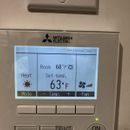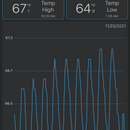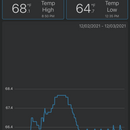Mitsubishi Hyper Heat overshooting temp
Hi. Home owner here in IECC zone 4C.
We have a garage conversion that we recently “upgraded.” Room is 26×25 with a 9′ ceiling. It was originally tied into the main house HVAC but the performance was poor, so we had that disconnected and in its place:
– Insulated the attic space (added 6″ rigid foam with 1″ air gap for vented roof assembly).
– Installed a Mitsubishi SUZ-KA15NAHZ Hyper Heat *ducted* minisplit.
– Installed a Broan HRV
– Installed an Aprilaire air filter
The ducts, HRV, and Aprilaire are all within the envelope. We have the wired remote controller: PAR-40MAA
Our problem is, the room is often too hot (we’re in the PNW, so temps are cool outside now). The room temp is often 3-4 degree F higher than the thermostat setting and seems erratic — it will be stable for a while and then suddenly begin climbing way above the set point.
That wouldn’t be too bad, if we could compensate for the difference… but apparently these minisplits cannot be set below 63 degree F.
What we have tried:
– The wired thermostat is on an external wall (insulated with fiberglass batts, but likely not well). We removed the thermostat and discovered a couple of holes made during installation that were not patched. Patched them but no difference seen.
– We have actually tried *two* different mitsubishi minisplits, since the company installed the wrong one the first time (it was not the hyper heat model). Both units have exhibited this same behavior.
– Apparently there is a 4-degree offset built into these units! I found this PDF for removing the offset:
https://www.mitsubishi-electric.co.nz/materials/Aircon/Info_Guides/Remotes/2_Wall_Mounted_Controllers/PAR-31(2)%20Removing%204%20Degree%20Offset.pdf
Discovering that was very encouraging and could explain everything. But I’ve made the above changes and we’re not seeming any difference.
So, my question is: any ideas on how to troubleshoot this further? Is there something else I need to change on the minisplit itself to honor the removal of that 4-degree offset?
Is there a different thermostat remote we should try? I saw reference to an MHK1 remote… would it make sense to try using that rather than the wall control? Is that possible?
Any other ideas? The company that installed everything seems stumped.
Worst case, is there another minisplit brand that would likely not exhibit this issue?
Also of note, in *cooling* mode, we are not seeing this problem. Set to 67 and it cools and maintains right around 67.
We have an AcuRite sensor in the space to track the temp. Attaching some photos so you can see the temp spikes. There’s no obvious correlation between outside temp changes and when we see these spikes. The wall controller is set to 63 degree F in all cases.
I did find some earlier threads that sounded related, but not clear on resolution:
https://www.greenbuildingadvisor.com/question/temperature-adjustment-offset-on-mitsubishi-minisplit
Any pointers would be greatly appreciated.
Thanks,
Maurice
GBA Detail Library
A collection of one thousand construction details organized by climate and house part













Replies
The images are being truncated for some reason. They're available here:
https://drive.google.com/drive/folders/1bwsU1t1shvhDfcdJPlfqY7LfqvgKvxjL?usp=sharing
I can't help but be a little suspicious that cooling mode does not have this problem. Maybe it's just an error with the Mitsubishi being broken in a particular way but I would look for a bigger picture viewpoint. In the summer heat is kept out primarily through attic or roof insulation. Radiant barriers can also help up there. In cold weather a lot of the low temperatures come through the floor.
It would be similar to having a single pane window and feeling cold in winter while sitting in front of it even though the average temperature is in a room is ok. If there is a large roof overhang shading that window in summer, you still won't have a problem with it being a single pane window. But that same window could be a big problem in presenting a cold "sink" in winter. The same identical properties of wall or floors can affect heating much more than cooling. If you put a thermostat close to that window or too close to an under insulated floor you would get the overshooting effect in winter but not summer.
It could also be just a coincidence of the way the heat pump is "broken". But I would look into this as a cause for the difference in heating and cooling.
Thank you, Eric.
We placed the AcuRite sensor in the middle of the room on a table to compare with the wall thermostat temp and they are very close, so we tended to discount that as the cause. But maybe there's a compatible remote thermostat sensor or something we could use to confirm?
The room also has a ceiling fan. We've left that on to mix the air, but no difference seen.
If we turn heating/cooling off on the minisplit, and just leave the fan running, the room temp does drop. But in heating mode, it never seems to allow the temp to get down to to the set point of 63 F. You can see in the acurite graphs, it always starts heating above that set point (and again with the temp reported on the wall and in the middle of the room matching). We've never seen the temp actually get down to 63 F in heating mode.
When I look at the graph I see the unit cycling on and off at its minimum speed.
The problem with running at min speed is the refrigerant is flowing at too low a velocity to carry the oil mixed with the refrigerant back to the compressor. So a few times each hour the computer in the mini split will run at full speed for enough time to get the oil back to the compressor and this is when you see the spikes in the room temp.
Does it seem like the unit is running at full speed when it is in cooling mode?
I am guessing the unit is way oversized for your heating load.
Walta
The oil control shows up well on my electricity monitor graph. At minimum capacity (200-240 watts) my Midea will surge the compressor every 15 mins. You can see the 4 spikes on the graph.
Over-sized or not, your thermostat should keep the unit off until the room drops below the set point. You can test if a better match to load fixes it by cracking a window open.
Your graph shows temperature increasing for about 30 minutes, which is way beyond what oil circulation should require.
You should switch the thermostat from basic mode to full mode to get more information about how it is configured.
Make sure it is configured for sensing temperature at the thermostat instead of the indoor unit. "See "Built-in sensor on the remote controller" in the installation manual.
Maybe do a reset to factory default. Try disabling "auto mode".
Thanks, Jon. Our display does appear to be in full mode, AFAICT. We did change the temp sensor setting. It's on mode 2 setting 3, "built-in sensor on the remote controller" and the wall temp agrees with the acurite.
So by cracking a window, the idea is to basically uninsulate the room, eliminating any short-cycling, and demonstrating whether the unit can maintain temp?
I can tell you that so far, it never reaches the set point of 63 F.
I have a ducted Fujitsu with a wired remote (thermostat) and even if I configure the unit to use the remote temperature sensor, it will revert back to the internal return air sensor if there is more than a few degree difference between the two. Not sure if Mitsubishi units are the same.
Can you describe your cold air return setup? Anyway it’s against an uninsualted wall or something that is causing the return air to be cooler than the room temperature?
I agree with Jon, if it’s oversized it should be short cycling on and off, not drastically overshooting the set point.
Your issue is the minimum heating capacity on that Mitsubishi is 8800 btu/h so it's probably way oversized for a 625 sqft well insulated place in the Pacific NW under low loads. Do you have any heat loss numbers for the space?
I use the same accurite sensor and your unit is just short cycling on and off at minimum capacity. Your graph is what most forced air furnace looks like that blast heat and cycle on and off. I attached a picture from my acurite sensor for comparison. Notice over the 12 hours the temperature only deviated a degree or less. Its a good visual of how well a properly sized mini splits can deliver a comfortable even temperature.
To really see what the unit is doing you will need to install an electricity monitor. See my reply to Walter for an example of one I have connected to my unit.
Here is the submittal for your unit with the capacities.
http://ld3.melsup.com/item/SUZ-KA15NAHZ.html#Submittals
Thank you, BFW577. What are you using for the electricity monitoring?
+1 to BFW577 and Walta's suggestion of an oversized heating capacity causing the problems.
Thanks for the replies. We'll talk with the installation company and see if they agree the unit may be oversized.
Unfortunately I don't think the current unit will ever run efficiently. Not sure why that Mitsubishi has such an enormous minimum capacity. Many other ducted units like this Carrier/Midea linked below can turn down to around 2000 or less btu/h. I'm in climate zone 4 as well and use the floor console version of the same unit. Its very low minimum capacity makes it hard to oversize
Its also possible that your Mitsubishi dealer might be able to use another outdoor unit with a lower minimum capacity with your existing cassette.
https://ashp.neep.org/#!/product/47328
Understand the large capacity of the current unit may be necessary for the cooling loads the unit will see in the summer.
Walta